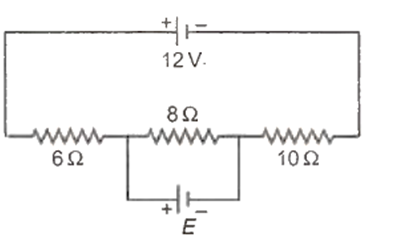 Multiple Choice Questions
Multiple Choice QuestionsThe force between two parallel current carrying wires is independent of
their distance of separation
the length of the wires
the magnitude of currents
the radii of the wires
The graph between resistivity and temperature, for a limited range of temperatures, is a straight line for a material like
copper
nichrome
silicon
mercury
A 100 W bulb produces an electric field of 2.9 Vm-1 at a point 3 m away. If the bulb is replaced by 400 W bulb without distributing other conditions, then the electric field produced at the same point is
2.9 Vm-1
3.5 Vm-1
5 Vm-1
5.8 Vm-1
In the circuit shown, the current through 8 Ω is same before and after connecting E. The value of E is

12 V
6 V
4 V
2 V
An electric bulb rated 500 W at 100 V is used in a circuit having a 200 V supply. The resistance R that must be put in series with the bulb, so that the bulb draws 500 W is
10 Ω
15 Ω
20 Ω
25 Ω
C.
20 Ω
Two copper wires have their masses in the ratio 2 : 3 and the lengths in the ratio 3 : 4.The ratio of their resistances is
4 : 9
27 : 32
16 : 9
27 : 128
Two different conductors have same resistance at 0°C. It is found that the resistance of the first conductor at t1°C is equal to the resistance of the second conductor at t2°C. The ratio of the temperature coefficients of resistance of the conductors, is
In the given circuit diagram the current through the battery and the charge on the capacitor respectively in steady state are

1 A and 3 µC
17 A and 0 µC
11 A and 3 µC
6 A and 0 µC
